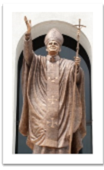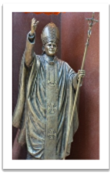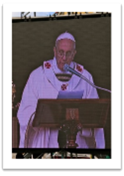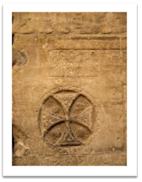
|
|
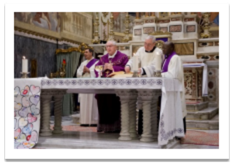
‘A Catechism of Christian doctrine’ states “The Holy Mass is the sacrifice of the body and blood of Jesus Christ, really present on the altar under the appearance of bread and wine, and offered to God for the living and the dead.” 150
The word ‘transubstantiation’ means a change of substance. The Church teaches that whole substance of the bread and wine is changed into the literal physical body and blood of Christ.
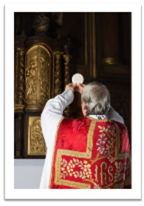
After the adoration of the consecrated “host”, the uplifted hands of the priest pretends to offer to God the very body of the blood of Christ as a sacrifice for the living and the dead. He then pretends to eat him alive and then he gives him to the people to eat him alive. 150
Reverend Charles Elliot states “The Romanists teach that that bread of which the priest, by consecration, makes Jesus Christ, is turned into the very substance which they adore. By consecration it is not made a representation of our Saviour, or his receptacle, but is turned into his very self… we call it a wafer, they call it Christ entire.” 8
Historian J Bonwick states that followers of Egyptian god Osiris commemorated his death by the Eucharist, eating the sacred cake, after it has been consecrated by the priests, and becomes veritable flesh of his flesh. 151
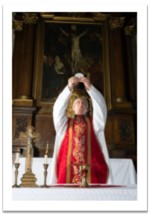
Early Christian writer Justin Martyr (100 A.D. - 165 A.D.) states: "Jesus said Do this in commemoration of me; this is my body. And having taken a cup, and returned thanks, he said: This is my blood, and delivered it to them alone. Which thing indeed the evil spirits have taught to be done out of mimicry in the Mysteries and Initiatory rites of Mithra. For you either know, or can know, that bread and a cup of water (or wine) are given out, with certain incantations, in the consecration of the person who is being initiated in the Mysteries of Mithra." 85
Early Christian writer Tertullian (155 A.D. – 240 A.D.) states ”The Eucharist of the Lord and Saviour, as the Magi called Mithra, the second person in their Trinity, or their Eucharistic sacrifice, was always made exactly and in every respect the same as that of the orthodox Christians, for both sometimes used water instead of wine, or a mixture of the two.” 85
In 1836 Reverend J. O’Neill writes a discourse to the Church Parish stating that Transubstantiation is contradictory to the scripture, he states “In the darkest days of heathen priest craft, the human intellect was never more prostrated or domineered over, than by this one doctrine of Transubstantiation; in the grossest barbarism of pagan times, more gross or flagrant idolatry could not be practised than by the Romanist, in bowing down before his wheaten idol at (what they call) the elevation of the host – worshipping flour and water, as if it were really the God of the Universe” 152
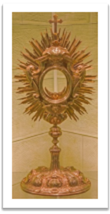
The whole Catholic mass has its similarities with the pagan religions. All the pagan rituals seemed to have been merged into Christianity. The Eucharist once transubstantiated into Jesus is then placed into a “Monstrance” that looks like a sunburst (i.e. representing the sun). The pagan religions mentioned are forms of sun worship, worshipping their sun gods. The section ‘The Jesus you worship is not the real historical Jesus’ demonstrates that the ‘Jesus’ the Christians are worshipping is not the real historical Jesus but just a Roman name for their sun gods.
Hymn singing and the use of musical instruments was used in many forms of pagan worship. 153 The use of bell, candles, and holy water came from Mithraism. 90
“We need not shrink from admitting that candles, like incense and lustral water, were commonly employed in pagan worship and in the rites paid to the dead.”
“We must not forget that most of these adjuncts to worship, like music, lights, perfumes, ablutions, floral decorations, canopies, fans, screens, bells, vestments, etc. were not identified with any idolatrous cult in particular; they were common to almost all cults.” Catholic Encyclopaedia 154
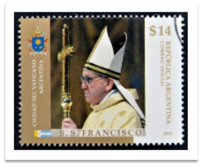
 According to the Encyclopaedia of Religion and Ethics: Babylon pagan priests also wore a Mitre hat just like the Roman catholic pope and bishops wear. 155
According to the Encyclopaedia of Religion and Ethics: Babylon pagan priests also wore a Mitre hat just like the Roman catholic pope and bishops wear. 155
The mitre hat was also used in the pagan Mithraic faith. The name Mitre originates from Mithra. 156
The Popes wearing the Maltese Cross |
|||
|
|
|
|
The ancient Egyptians, Persians and Babylonians worshipped this cross as a sacred symbol. It can be found on their oldest monuments. Ancient colossal tablets show ancient kings wearing this cross on their chest 157 158 |
The same cross can be found at the Temple to Isis, Horus and Osiris on Philae Island on the River Nile in Egypt |
||
| Carrying and kissing the statues | <<< Prev | Next >>> | What famous people said about Christianity |

